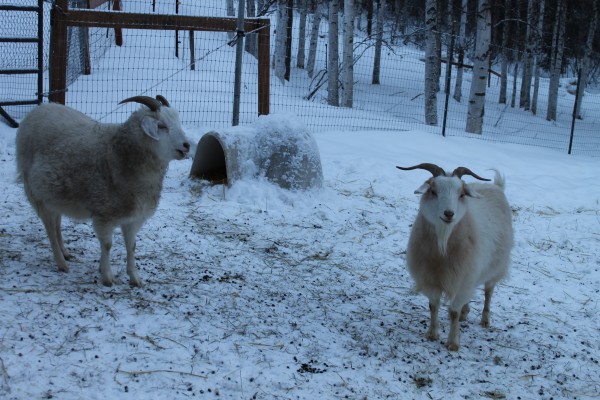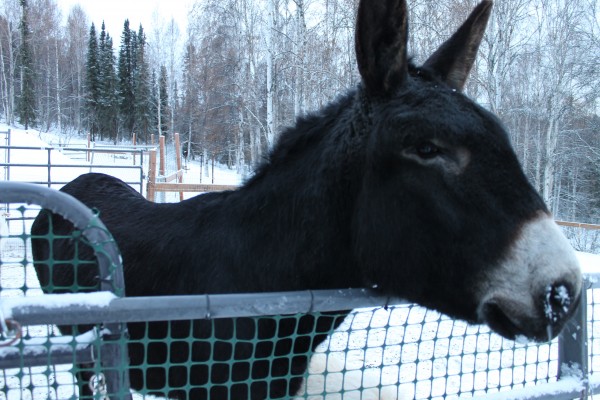UAF retiree raises cashmere goats
January 26, 2015

By Nancy Tarnai
907-474-5042
1/26/2015
After retiring from the UAF Reindeer Research Program and Large Animal Research Station, Sandy Garbowski is enjoying being at home caring for her own animals.
At Willow Hill Farm north of Fairbanks, Garbowski raises cashmere goats, turkeys and chickens. The newest addition is Buddy, a strikingly handsome, friendly burro adopted from Nevada through the U.S. Bureau of Land Management's National Wild Horse and Burro Program.
The burro is in charge of protecting the herd from loose dogs and other predators. At first, Buddy wasn’t sure what to think of the goats, but he is so used to them now that he allows one to stand underneath him to munch hay away from the other goats. An Australian cattle dog helps herd the goats when it’s time to move them to different pastures.
Garbowski grew up in California and started raising goats when she got to college. “I always liked animals,” she said. “I wanted to raise fiber animals because I don’t like to milk.” Willow Hill has a couple of dairy goats and a couple of meat goats, but the majority of the herd is the kind that produces cashmere wool.
Any goat can grow cashmere, but true cashmere goats have been bred to produce the soft, downy fiber in greater amounts. Willow Hill may be one of the only cashmere goat farms in Fairbanks, but there are a few others around the state. After combing the fiber, Garbowski sends it to a mill to be processed into raw fiber and yarn.
“I’m still waiting to see if the fiber sales will pay for the hay,” Garbowski said.
The 20-acre farm is set on a beautiful hillside off the Steese Highway. Originally, Garbowski raised horses and llamas. When the last mare died, she decided to get a few goats and eventually found herself with a herd. The animals proved entirely different from horses. “There is the herd dynamics with goats,” Garbowski said. “Everybody has a different place.”
All the goats are named and will come when called. They handle the Alaska winters quite well, enjoying an insulated “club house” in the barn when it gets extremely cold.
“I just like animals,” Garbowski said. “I like the chores. I like looking out my kitchen window and seeing the herd of animals.”

One drawback is buying hay for winter feed because it is so expensive. In the summer, the animals can eat off the land. Another challenge is fencing. “Goats always want to be on the other side,” Garbowski said.
She separates the bucks and does this time of year to better control a spring arrival of kids. Her goal is for them to be born in late April or May. “In greenup, the moms get better nutrition, and it’s more fun to play with them when it’s sunny and green,” she said.
Garbowski looks forward to the day she breaks even or makes a profit. “I enjoy having the animals and working with fiber. I just haven’t quite figured out the costs to keep them versus the fiber sales. There are economies of scale. Maybe I’ll break even. Maybe I’ll make a fortune, but probably not.
“I love the animals so much; they’re my reason for getting up in the morning.”
Garbowski hopes to see more cashmere farms in the area. She said people who raise goats are generally willing to help each other and give advice to those just starting out. She cautioned that goats are herd animals, so she doesn’t advise having a single goat as a pet.
She is creating a website, www.willowhill.farm, but it isn’t live yet. Her email is willowhillalaska@gmail.com.
Nancy Tarnai is a public information officer with the UAF School of Natural Resources and Extension's Agricultural and Forestry Experiment Station in Fairbanks.


